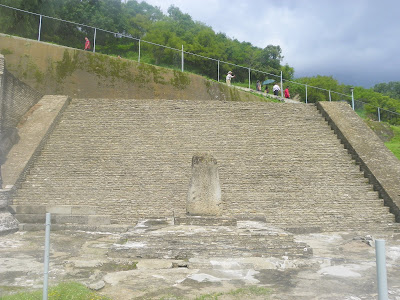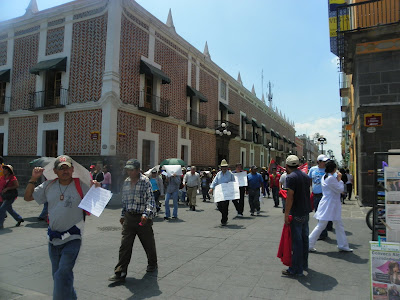Well, here is my beautiful school! Secundaria Constitucion de 1917. The tiled walls were washed for the first day of school, then recovered with fresh grafiti, I think within 24 hours. Not wanting to further engage in the exercise of futility, the walls remain as you see them here, even though soap and water could remove the decoration. What would be your first impression to fill a role in a school like this?
One thing you might notice within Mexico, as an American, is a certain amount of order within disorder, whereas American society has a heavier amount of disorder within order. In fact my heart sank a little, not that I expected more, but that seeing the school in real life caused me to wonder how I was going to survive the year! If this were inner city L.A. or Oakland, I feel, one would have real reason for concern. The grafiti there suggests anger, disaffection, rebellion. Here, though, it suggests boredom, subversion, mischief. It is gentler grafiti than what you would find in the states.
The order within was manifest the first day as the school congregated for "ceremonia," the Monday morning ritual with a formal flag ceremony and instructions from the vice principal. The principal was no where to be found! Most everyone had their "gala" uniforms even though technically they had a month still to acquire them. It was an impressive sight! The proceedings were convened with militant precision. I was amazed to see how, being the first day of class, the color guards (always female) were in perfect step. I guess with a shorter summer, they don't forget things as gravid as the flag ceremony. The vice principal spoke of rules such as no make up for girls, no gel for boys, and shoes are to be shined regularly. I found it amazing that a school with the exterior you see would be concerned with the quantity of dust on shoes. Could you imagine such a demand in an American school?
But, make no mistake, there
is disorder in the school. As with the grafiti, however, it is gentler disorder. There are plenty of paper airplanes, noisemakers, notes, gags, even, gasp, occasional smudges of gel in boy's hair. It comes as a wave of adolescent anticipation and the energy can be difficult to channel. I have seen many Mexican teachers orchestrate the scene gracefully. As a first year teacher, I am learning, little by litte. Communication is challenging. While I know enough Spanish to direct the class, it is very difficult to hear what the students are saying. They are noisy all the time except during ceremony or when they are talking to me in class. And they assume I can adjust to the rythm and flow of cotidian communication they are accustomed to. One humorous example came as I learned the word "simulacro." The prefecta (dean of discipline) came to class and told me there was a simulacro in 15 minutes. I said What? and she explained that in 15 minutes, I can leave and the students leave. Since it was towards the end of the day on September 15, Mexico's independence day, I thought they were letting everyone go home early and they had a word for it: simulacro. The kids were working on a task so, to motivate them, I said that no one could go to the simulacro unless they finished their assignment. Imagine the firemen's displeasure of finding that a teacher was retaining students to finish assignments during a fire drill! !
I have never seen such "cuteness" in students before. Outside of class, they are so interested in talking with you, swarming you, asking a million questions, offering to take your materials to class for you, etc. They are so much fun to be with! Inside class, for the necessities of the tasks at hand, they are not always easily persuaded to put their cutenss on pause. Some days I feel I am "reganando" (scolding) 80% of the time and teaching 20%. They love chorus responses and chant like songs, which I confiscated from Daniel's school materials from Nevada virtual academy. They do not like assignments where they have to produce the product as opposed to copy or decorate something.
When I arrived, the Fulbright arrangement which the school administrators approved included 25 classroom hours per week. Esteban had 34 hours on his load. To the administrator's credit, they honored the agreement which they had signed, and I was told they would work on getting another teacher to cover the 9 additional hours. The first week of classes, however, there was no other teacher. I asked around and found out that sometimes that happens, that the school is short teachers for certain hours and the kids simply sit there "echando relajo" the entire time unsupervised. As much as I would love to have had a 25 hour teaching week, I realized it was not right to leave those kids unattended, so I offered to take the classes. They said it would be until the new teacher came, but I knew well that meant until the cows come home. They are still grazing. It is a very demanding schedule! Imagine absorbing the energy of 45 7th and 8th graders seven times a day in whatever nation! I come home barely able to function:)
I love how when you do have to reganar students, they don't hold it against you the way my American students often do. In the states you have to worry about ticking off certain students because you have to live with them the 180 days of the school year, and once you start down the path of disaffection, it is very difficult to reclaim a positive relationship. Here, it is another story. The students quickly admit their fault and quickly say something like "Si, maestro" or at least nod approvingly. One time the computer teacher sent someone to find out who participates in "grafiti" art, even within their notebooks. Knowing that whoever volunteered would have to face the consequences of having grafitied the computer lab, it was startling to see some 10 or 15 kids admit to the pastime. The consequence was to paint the benches that were damaged with their own paint. This kind of honesty doesn't mean that the students change their behavior, usually, but there is not the vindictive, untouchable attitude that sometimes plagues our students to the north.
Of course you will guess that the school runs on limited resources multiplied a thousand times in relation to limited resources in the United States. At times, even the power is cut off. Most of the classrooms have broken windows and noise carries throughout the school. A couple of rooms are equipped with modern computers and built in projectors, but these help little since the kids stay in the classroom and the teachers move from class to class. It would not be efficient to make a nice presentation for the one or two groups who would be able to watch it. My best piece of technology is a CD player left by Esteban for Daniel's chant CD and the books actually came with a CD for each level. I was pleasantly surprised to receive consumable workbooks for the students. . . at least it is something to use as a tool. There is no copy facilities and if I want to give them copies, I am supposed to charge the students first. I haven't done so yet, but I must very soon for the bimestral exams coming up.
I truly enjoy the friendship with all of my colleagues as they accepted me swiftly into Esteban's primary social circle. Each day we walk to a small "kitchen" where the same lady, Araceli, makes "desayuno" for us. We eat very well, very healthy, a nice warm meal for about a dollar a day. Aside from this daily ritual, there is very little time for collaboration. At last we had a staff meeting a couple weeks ago, and a second one today. It wasn't on policies and systems of the school, but on the nuances of competency based instruction. I am desperate for collegial information on how the game is played in the different classrooms. I didn't even get class lists until the second or third week, and that because I went to the secretaries and asked for them. Oh well. Thus far my spirits are easily restored following whatever disappointment because of the joy of the adventure. I feel that every sight, from the ceremony to a typical class, is a rare opportunity for one such as myself to experience, to share, to enjoy, and to learn from. I hope we can have enough energy, or enough ability to recharge our strength the length of the school year.









































